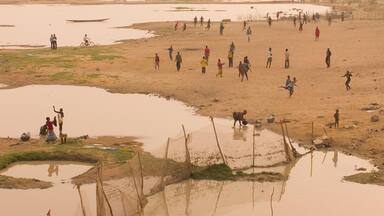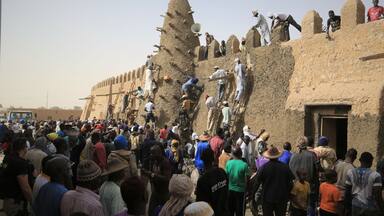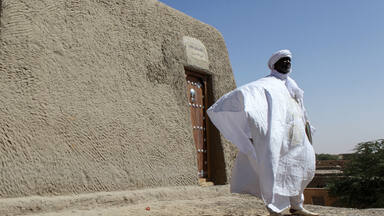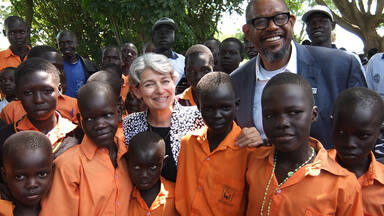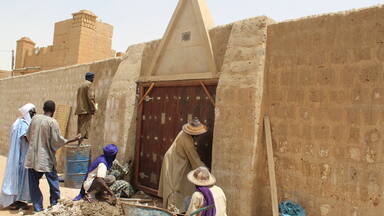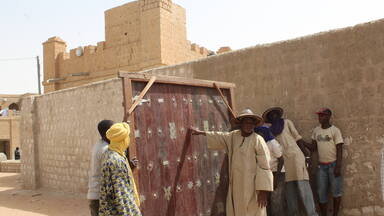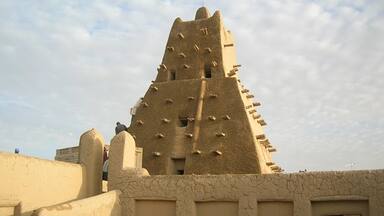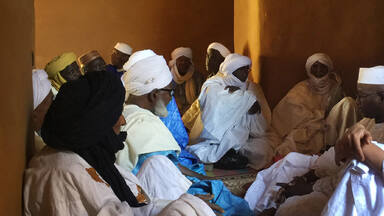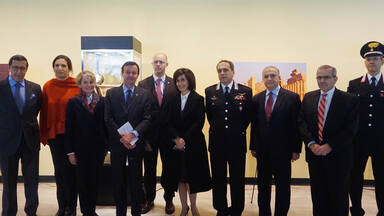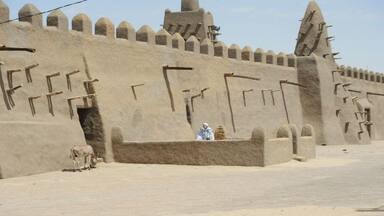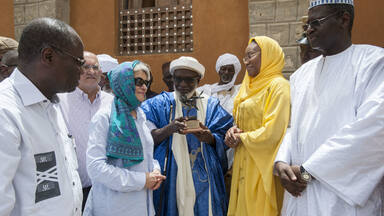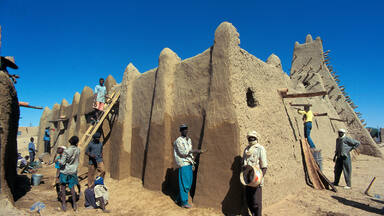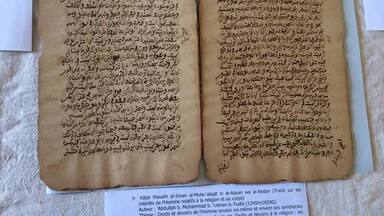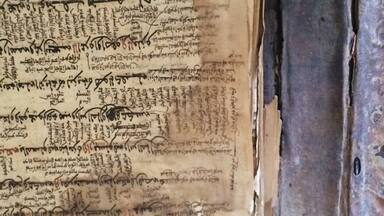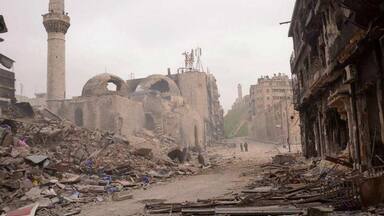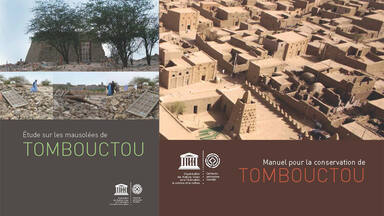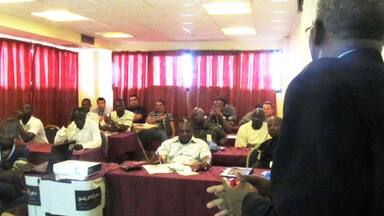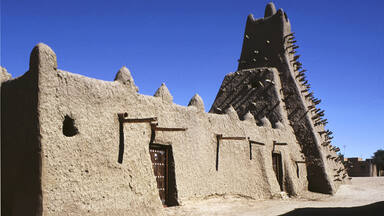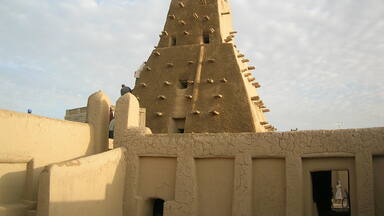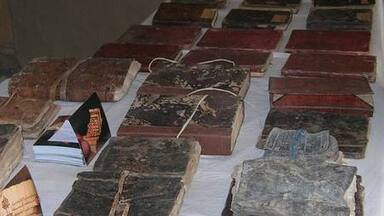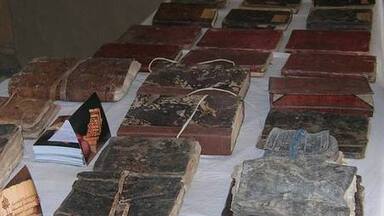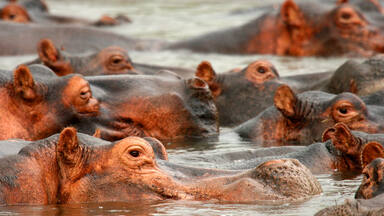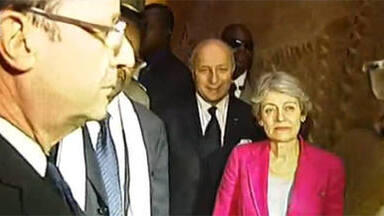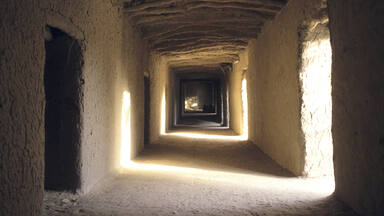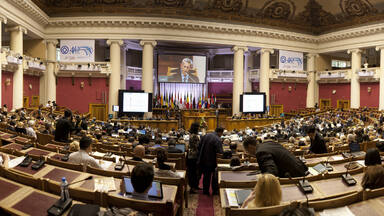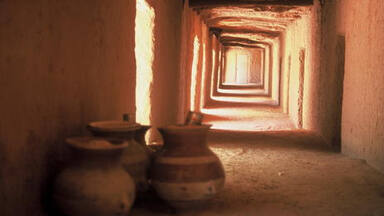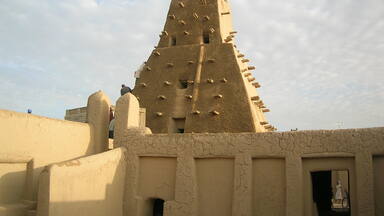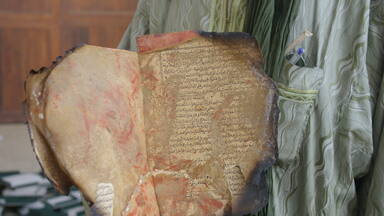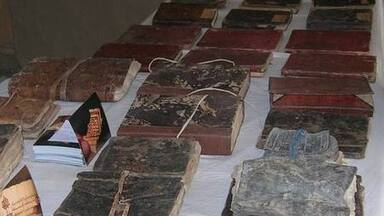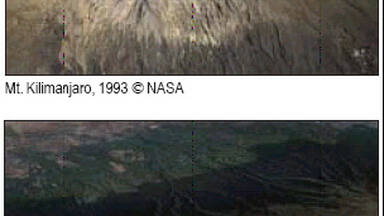Timbuktu
Timbuktu
Home of the prestigious Koranic Sankore University and other madrasas, Timbuktu was an intellectual and spiritual capital and a centre for the propagation of Islam throughout Africa in the 15th and 16th centuries. Its three great mosques, Djingareyber, Sankore and Sidi Yahia, recall Timbuktu's golden age. Although continuously restored, these monuments are today under threat from desertification.
Description is available under license CC-BY-SA IGO 3.0
Tombouctou
Dotée de la prestigieuse université coranique de Sankoré et d'autres medersa, Tombouctou était aux XVe et XVIe siècles une capitale intellectuelle et spirituelle et un centre de propagation de l'islam en Afrique. Ses trois grandes mosquées (Djingareyber, Sankoré et Sidi Yahia) témoignent de son âge d'or. Bien que restaurés au XVIe siècle, ces monuments sont aujourd'hui menacés par l'avancée du sable.
Description is available under license CC-BY-SA IGO 3.0
تمبوكتو
كانت تمبوكتو التي تتميّز بالمسجد الجامعي المدهش الواقع في سانكوري وبمدارسَ أخرى، في القرنَيْن الخامس عشر والسادس عشر، عاصمةً فكريّةً وروحيّةً ومركزًا لنشر الاسلام في أفريقيا. فمساجدها الثلاثة (جينقري بير وسانكوري وسيدي يحي) تشهد على عصرها الذهبي. وبالرغم من ترميمها في القرن السادس عشر، تُعتبَر هذه النصب الأثريّة مُهدّدةً اليوم بفعل تقدّم الرمال.
source: UNESCO/CPE
Description is available under license CC-BY-SA IGO 3.0
廷巴克图
这里是声名显赫的科兰尼克·桑科雷大学的所在地。廷巴克图在公元15世纪至16世纪成为了宗教文化中心,同时也是伊斯兰文化向非洲传播的中心。津加里贝尔、桑科尔和西迪·牙希亚这三座雄伟的清真寺反映了廷巴克图的黄金年代。尽管这些建筑不断地被修复,但是今天它们仍然受到风沙侵蚀的威胁。
source: UNESCO/CPE
Description is available under license CC-BY-SA IGO 3.0
Исторический город Томбукту
Томбукту, место нахождения престижного университета Кораник-Санкоре и других медресе, являлся интеллектуальной, духовной столицей и центром распространения ислама в Африке в XV-XVI вв. Его три больших мечети – Джингеребер, Санкоре и Сиди Яхья – напоминают о «золотом веке» Томбукту. Несмотря на постоянно осуществляемые работы по консервации, эти памятники находятся сегодня в угрожающем положении из-за наступления пустыни.
source: UNESCO/CPE
Description is available under license CC-BY-SA IGO 3.0
Tombuctú
Sede de la prestigiosa universidad coránica de Sankoré y varias madrazas, Tombuctú fue durante los siglos XV y XVI una de las capitales intelectuales y espirituales del Islam y un foco de propagación de esta religión en África. Las tres grandes mezquitas de Djingareyber, Sankoré y Sidi Yahia son testigos de su edad de oro pasada. Pese a los continuos trabajos de restauración realizados, estos monumentos se ven amenazados hoy en día por el avance de la arena.
source: UNESCO/CPE
Description is available under license CC-BY-SA IGO 3.0
トンブクトゥ
source: NFUAJ
Timboektoe
Timboektoe staat bekend om de prestigieuze Koranuniversiteit van Sankore en andere madrassas (moskeescholen). Timboektoe was een intellectuele en geestelijke hoofdstad en een centrum voor de verspreiding van de islam door Afrika in de 15e en 16e eeuw. De stad – gesticht in de 5e eeuw – kende toen haar economische hoogtepunt en werd met haar universiteit en talrijke scholen een belangrijk centrum van de volgens de Koran gevormde cultuur. Geleerden, technici, architecten en geestelijken trokken er samen op. De drie grote moskeeën Djingareyber, Sankore en Sidi Yahia herinneren aan de Gouden Eeuw van Timboektoe. Ze worden bedreigd door het gewapend conflict in de regio en daarnaast door woestijnvorming, ondanks voortdurende restauraties.
Source: unesco.nl
Outstanding Universal Value
Brief synthesisLocated at the gateway to the Sahara desert, within the confines of the fertile zone of the Sudan and in an exceptionally propitious site near to the river, Timbuktu is one of the cities of Africa whose name is the most heavily charged with history.
Founded in the 5th century, the economic and cultural apogee of Timbuktu came about during the15th and 16th centuries. It was an important centre for the diffusion of Islamic culture with the University of Sankore, with 180 Koranic schools and 25,000 students. It was also a crossroads and an important market place where the trading of manuscripts was negotiated, and salt from Teghaza in the north, gold was sold, and cattle and grain from the south.
The Djingareyber Mosque, the initial construction of which dates back to Sultan Kankan Moussa, returning from a pilgrimage to Mecca, was rebuilt and enlarged between 1570 and 1583 by the Imam Al Aqib, the Qadi of Timbuktu, who added all the southern part and the wall surrounding the cemetery located to the west. The central minaret dominates the city and is one of the most visible landmarks of the urban landscape of Timbuktu.
Built in the 14th century, the Sankore Mosque was, like the Djingareyber Mosque, restored by the Imam Al Aqib between 1578 and 1582. He had the sanctuary demolished and rebuilt according to the dimensions of the Kaaba of the Mecca.
The Sidi Yahia Mosque, to the south of the Sankore Mosque, was built around 1400 by the marabout Sheik El Moktar Hamalla in anticipation of a holy man who appeared forty years later in the person of Cherif Sidi Yahia, who was then chosen as Imam. The mosque was restored in 1577-1578 by the Imam Al Aqib.
The three big Mosques of Djingareyber, Sankore and Sidi Yahia, sixteen mausoleums and holy public places, still bear witness to this prestigious past. The mosques are exceptional examples of earthen architecture and of traditional maintenance techniques, which continue to the present time.
Criterion (ii): The mosques and holy places of Timbuktu have played an essential role in the spread of Islam in Africa at an early period.
Criterion (iv): The three great mosques of Timbuktu, restored by the Qadi Al Aqib in the 16th century, bear witness to the golden age of the intellectual and spiritual capital at the end of the Askia dynasty.
Criterion (v): The three mosques and mausoleums are outstanding witnesses to the urban establishment of Timbuktu, its important role of commercial, spiritual and cultural centre on the southern trans-Saharan trading route, and its traditional characteristic construction techniques. Their environment has now become very vulnerable under the impact of irreversible change.
IntegrityThe three mosques and the sixteen mausoleums comprising the property are a cliché of the former great city of Timbuktu that, in the 16th century, numbered 100,000 inhabitants. The vestiges of urban fabric are essential for their context. However, as indicated at the time of inscription of the property, rampant urbanization which is rife in Timbuktu, as in Djenne, is particularly threatening to the architecture, and the large public squares and markets. Contemporary structures have made irretrievable breaches in the original parcelling and obviously exceed the scale of the traditional buildings. This process is ongoing and most recently a new very large institute was built on one of the public squares, compromising the integrity of the Sankore Mosque. Urban development pressures, associated with the lack of maintenance and flooding, resulting from the heavy rains, threaten the coherence and integrity of the urban fabric and its relation to the property.
The three mosques are stable but the mausoleums require maintenance, as they are fragile and vulnerable in the face of irreversible changes in the climate and urban fabric.
AuthenticityThe three mosques retain their value in architectural terms, traditional construction techniques associated to present-day maintenance, and their use. However, the Sankore Mosque has lost a part of the public square that was associated with it following the construction of the new Ahmed Baba Centre. Following this construction, the status of the mosque in the urban context and part of its signification have been compromised and require review and reconsideration.
Overall, because of the threat from the fundamental changes to the traditional architecture and the vestiges of the old city, the mosques and mausoleums risk losing their capacity to dominate their environment and to stand as witnesses to the once prestigious past of Timbuktu.
Protection and management requirementsThe site of Timbuktu has three fundamental management tools: a Revitalization and Safeguarding Plan of the Old Town (2005), and a Strategic Sanitary Plan (2005), that are being implemented despite certain difficulties; and a Conservation and Management Plan (2006-2010) is being implemented and which shall be reassessed shortly.
The management system of the property is globally appropriate as its legal protection is jointly assured by the community of Timbuktu through management committees of the mosques, the cultural Mission of Timbuktu and the Management and Conservation Committee of the Old Town of Timbuktu. This mechanism is strengthened by two practical functioning modalities, initiated in consultation with the World Heritage Centre: the Town Planning Regulation and the Conservation Manual. The specific long-term objectives are the extension of the buffer zone by approximately 500 m to assure the protection of the inscribed property ; the development of the historic square of Sankore to integrate corrective measures proposed by the Committee at its 33rd session and by the reactive monitoring mission of March 2010 ; the extension of the inscribed property to include the entire Timbuktu Medina ; the development of an integrated conservation and sustainable and harmonious management project for the site, in the wider framework of development of the urban commune and in close cooperation with the elected members of the Territorial Communities of Timbuktu and the development partners ; the active conservation of the mausoleums.
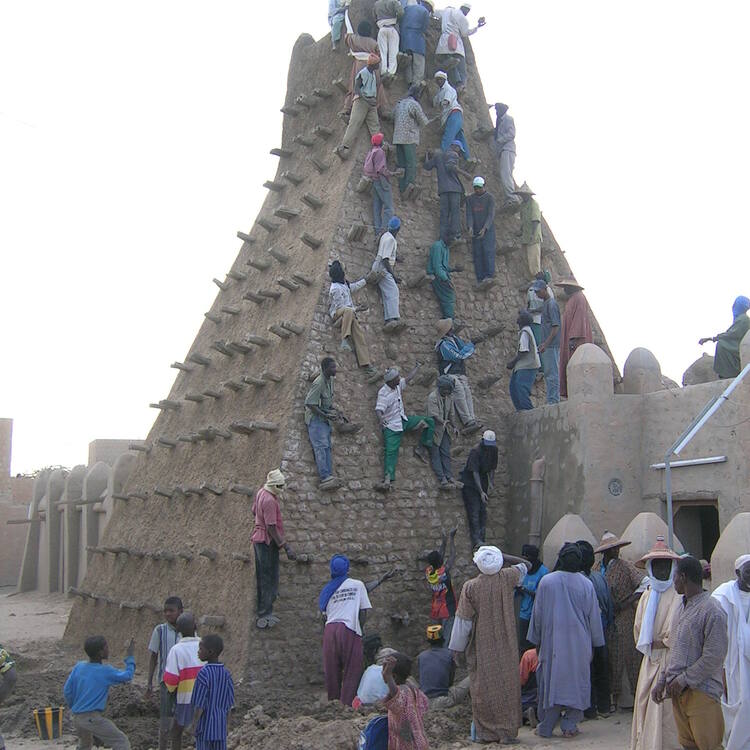
 View photos from OUR PLACE the World Heritage collection
View photos from OUR PLACE the World Heritage collection
